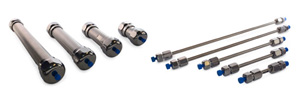how to clean the ion exchange column
How can the columns be cleaned or regenerated?
> back to HPLC FAQ
Increased back-pressure, changes in retention times/loss of column performance are all common symptoms of deposits on the column inlet frit, in the column or on the surface of the stationary phase. Most of the times, these problems can be overcome by the use of a correctly applied washing procedure. The sooner you use the column regeneration procedures the more chances you have to recover your column original performance.
Strongly adsorbed species are collected at the solvent-inlet end of the column and in many cases it is a benefit to use a reversed flow during washing. Contrary to popular belief reversing the flow will never harm a column that is well packed. The mentioned flow direction is usually the direction in which the column was originally packed. Please note that the irregular/amorphous original silicas nevertheless represent a possible problem when reversing the flow as possible restructuration of the packed bed is then possible. Extreme care should always be taken when reversing the flow on these irregular silicas.
Please check our suggested regeneration procedures for the different family of phases (RP, NP, Ion Exchange etc.) and perform the CoA column test after these procedures, should the original pressure be restored, in order to assess the column performance/peak symmetry.
SiliaChrom Cleaning and Regeneration Procedures
If adequate care is taken, it is possible to maintain column efficiency and reliability over an extended period of time. This section is intended to give information on the different procedures to help extend HPLC column lifetime.
Difference between cleaning and regeneration
We usually make the assumption that, after a separation, all the material initially present in the column or cartridge has been eluted. After a run, the column is simply washed with 2-3 column volumes of the initial solvent mixture before starting a new separation. However, some impurities that are strongly retained on the column will accumulate at the intlet, if the mobile-phase composition is not strong enough to elute them during a regular run. Some non-negligible problems can arise when this happen: loss of performance, back-pressure build up, peak tailing, retention time shift or baseline drift. To avoid this, it is highly recommended to perform regular cleaning of the column before any of these symptoms occurs. This process is simple and does not require modification of the usual chromatographic set up. When cleaning is not sufficient, a more thorough treatment, i.e. regeneration, may be necessary to avoid discarding the column.
Suggested Cleaning and Regeneration Procedures
The more you use a cleaning procedure, the less rigorous conditions be necessary. Cleaning should be performed after running a known "dirty" sample. Regeneration procedure should be performed prior to column storage, or when a column seems clogged. The flow rate is usually set lower than during the separation (typically from 20% to 50%).
Column Volume (packing's volume included) in mL = π x [Column Radius in cm]2 x [Column Length in cm]
| SiliaChrom Suggested Cleaning and Regeneration Procedures | ||
|---|---|---|
| Column | Suggested Cleaning Procedure | Suggested Regeneration Procedure |
| SiliaChrom HPLC Column | - Set the flow rate (20 to 50% of the usual one) - Rinse with 2-3 column volumes of each of the following solvents | - Backflush the column - Set the flow rate (20 to 50% of the usual one) - Rinse with 10 column volumes of each of the following solvents |
| Reversed-Phase Columns (C18, C8, C4, C1, Amine, Cyano, Phenyl, PFP, etc.) | - Water/ACN (95/5) to remove buffer - Water/ACN (5/95) - Mobile phase used during the separation | - Water/ACN (95/5) - THF - Water/ACN (5/95) - Mobile phase used during the separation |
| Normal Phase Columns (Amine, Cyano, Diol, etc.) Note: Never use water. | - MeOH/CHCl3 (50/50) - Ethyl Acetate - Mobile phase used during the separation | - MeOH/CHCl3 (50/50) - Isopropanol and ethyl acetate - Mobile phase used during the separation |
| Unbonded Silica Columns (Silica) | - Hexane, isopropanol and dichloromethane - Mobile phase used during the separation | - Hexane, isopropanol and dichloromethane - Mobile phase used during the separation |
| Ion Exchange Columns (SCX, SAX, etc.) | - 5 mM Phosphate Buffer pH 7.00 - Acetic Acid/Water (10/90) - Water, methanol and water | - 5 mM Phosphate Buffer pH 7.00 - Acetic Acid/Water (10/90) - Water, methanol and water |
It is highly recommended to verify the column performance efficiency after running restoration procedures in order to evaluate its performance.
Discover our HPLC products

- HPLC columns
- Reversed phases
- Normal phases
- Ion exchange phases
- HPLC guard cartridges
- HPLC guard cartridge holders
how to clean the ion exchange column
Source: https://www.silicycle.com/faq/hplc/how-can-the-columns-be-cleaned-or-regenerated
Posted by: porteryouss1994.blogspot.com

0 Response to "how to clean the ion exchange column"
Post a Comment